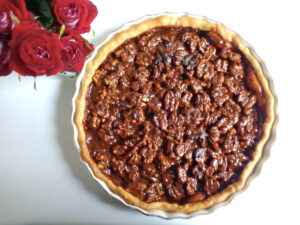
Walnut tart
This classic from southwest France is fun to make and a crowd pleaser as well. It makes a delightful dessert on festive occasions, or can be served at teatime or as the conclusion to a simple meal. The tart may be made in advance, although the tantalizing aroma emanating from your kitchen as it bakes may spark demands for a piece straight out of the oven.
For best results, use the freshest walnut pieces you can find and make the tart dough yourself. It’s a pâte sablée, or sweet pie crust. If you’re in a rush, however, you can also achieve fine results using good-quality store-bought pastry (uncooked). It should be regular pie dough (pâte brisée), and not puff pastry (pâte feuilletée).
The tart requires a 10-inch (25-cm) tart pan, and will serve 8-10 people. For a smaller tart, reduce the filling quantities by about a third and save the extra dough for another occasion (refrigerate or freeze). You could also make some tartlets with the extra filling and dough. This dessert will keep for several days if wrapped in foil and refrigerated.
For the crust:
1/4 lb. (110 g) unsalted butter, at room temperature
1 egg yolk
2 tbsp. white sugar
1 cup (130 g) plus 2 tbsp. flour
For the filling:
1/2 pound (250 g) walnut halves or pieces
2/3 cup (150 ml) heavy cream
1-1/2 cup (300 g) white sugar
6 tbsp. water
4 tbsp. (60 g, 1/2 stick) unsalted butter
2 tbsp. brown sugar, preferably demerara or cassonnade
Begin by making the tart shell. In a large bowl, cut the butter into small pieces. Using two knives, cut in the egg yolk, then the sugar, then the flour. This is easily done. Simply hold the knives parallel to each other and cut in opposite directions.
When the butter is well coated with flour, go in with your hands for the final blending. Mix until the dough is no longer sticky and holds together. You may need to add a bit more flour. Form a smooth ball and let the dough rest for a minute or two. Then pat the dough into your tart pan, taking care to ensure there are no cracks (do not prick the dough).
Refrigerate the tart shell while making the filling. (If using store-bought pastry, unroll it into your tart pan now and refrigerate). This step may be done several hours in advance.
When ready to prepare the filling, preheat the oven to gas mark 7 (400 F, 210 C).
Line a baking sheet or tin with parchment paper. Distribute the walnuts evenly. When the oven is hot, roast the walnuts for 5 minutes. Taste one. If it’s got that lovely toasted walnut flavor, remove the walnuts from the oven. If not, roast for a couple minutes more. Set the walnuts aside. Do not turn off the oven.
Pour the cream into a small saucepan and place over low heat.
In a large saucepan, combine the white sugar and water. Place over medium heat and stir until the sugar dissolves. Raise the heat and cook until the sugar turns a deep golden brown, about 5 minutes. From this point on, don’t stir — instead shake the pan from time to time so that the sugar browns evenly. Be careful, because this can go very quickly and it’s important not to burn the caramel.
Turn off the heat and gradually pour the warm cream into the hot caramel (if a skin has formed on the cream, remove it first). Stand back — the caramel will bubble like crazy. When the bubbling subsides, stir in the butter. Place over medium heat, add the walnuts and cook for 2 minutes, stirring occasionally.
Retrieve your chilled tart shell and pour in the filling. Sprinkle with the brown sugar.
Transfer the tart to the oven, turn down the heat to gas mark 6 (350 F, 180 C) and bake 20-30 minutes, until the crust is golden. Check halfway through to ensure that the walnuts are not cooking too quickly (turning dark). If they are, cover the tart loosely with a sheet of aluminum foil. If the tart is still bubbling when the crust is ready, that’s fine. The filling will set as the tart cools.
Serve the tart warm or at room temperature, perhaps with a bowl of crème fraîche or a small pitcher of heavy cream alongside. Serves 8-10.
The tart may be made well ahead of time and gently reheated just before serving.




